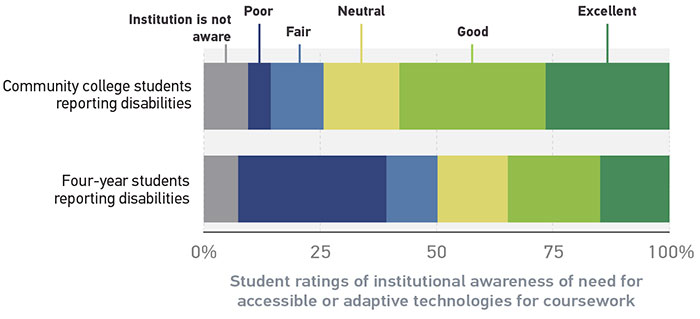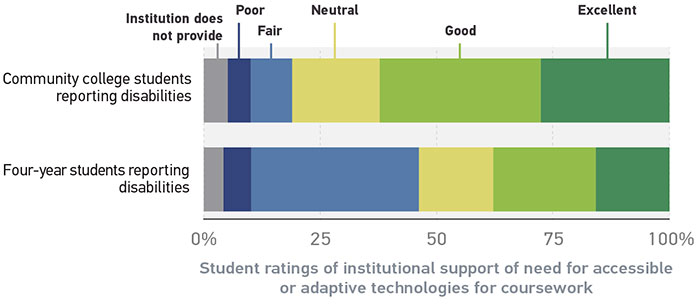Accessibility
We reported our findings regarding the technology experiences of students with disabilities for the first time in the 2018 student study to raise awareness of issues related to diversity, equity, and inclusion (DEI) in higher education IT. When we analyzed the data from community college students, it was clear: two-year and AA colleges are doing a significantly better job than other institutions of meeting the needs of students with disabilities who require accessible or adaptable technology for their academics. And the differences are striking. Of the 8% of community college students who identified as having a physical, learning, or both a physical and a learning disability, the majority (58%) reported their college's awareness of their needs as good or excellent (figure 6), and only 5% rated awareness as poor.

In stark contrast, at four-year institutions, good and excellent awareness ratings were significantly lower (35%) and about a third of students said awareness was poor. Students with disabilities at two-year and AA colleges also told us that their institutions are doing a better job of supporting their technology needs, as 63% rated their support positively. Ratings of fair given by community college respondents were also significantly lower (9%) than the fair ratings of their four-year college peers (36%) (figure 7).

Why might community college students give their institutions higher marks? Their experiences may be related to the fact that community colleges have historically served more diverse populations. National research tells us that more students with disabilities are enrolled at community colleges.1 According to the National Center for Education Statistics, of the undergraduate students with disabilities who were enrolled in postsecondary institutions, about half attended public two-year institutions.2 Since most community colleges have open admissions policies, students with disabilities may find them more welcoming. As a result of these larger enrollments, community colleges may have more experience serving this population and can be more responsive to their needs. Moreover, many community colleges offer transition programs that help students bridge the gap between high school and college; these programs also help them develop self-advocacy skills that can be applied when they transfer to four-year schools or join the workforce.3
Notes
-
"Students with Disabilities," Data Points 6, no. 13, American Association of Community Colleges, September 2018.
↩︎ -
K. Raue and L. Lewis, "Students with Disabilities at Degree-Granting Postsecondary Institutions," US Department of Education, National Center for Education Statistics (Washington, DC: US Government Printing Office, 2011).
↩︎ -
Grace Chen, "Students with Learning Disabilities Find Help in Community Colleges," Community College Review, April 26, 2018.
↩︎